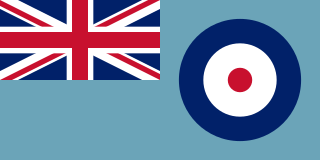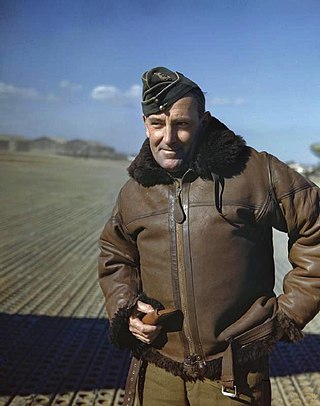
The Desert Air Force (DAF), also known chronologically as Air Headquarters Western Desert, Air Headquarters Libya, the Western Desert Air Force, and the First Tactical Air Force (1TAF), was an Allied tactical air force created from No. 204 Group RAF under RAF Middle East Command in North Africa in 1941 to provide close air support to the British Eighth Army against Axis forces. Throughout the Second World War, the DAF was made up of squadrons from the Royal Air Force (RAF), the South African Air Force (SAAF), the Royal Australian Air Force (RAAF), the United States Army Air Forces (USAAF) and other Allied air forces.

The Twelfth Air Force (12 AF; Air Forces Southern, (AFSOUTH)) is a Numbered Air Force of the United States Air Force Air Combat Command (ACC). It is headquartered at Davis–Monthan Air Force Base, Arizona.
The Mediterranean Theater of Operations, United States Army (MTOUSA), originally called the North African Theater of Operations, United States Army (NATOUSA), was a military formation of the United States Army that supervised all U.S. Army forces which fought in North Africa and Italy during World War II.

The Ninth Air Force (Air Forces Central) is a Numbered Air Force of the United States Air Force headquartered at Shaw Air Force Base, South Carolina. It is the Air Force Service Component of United States Central Command (USCENTCOM), a joint Department of Defense combatant command responsible for U.S. security interests in 27 nations that stretch from the Horn of Africa through the Persian Gulf region, into Central Asia.

Air Marshal Sir Arthur Coningham,, nicknamed "Maori", was a senior officer in the Royal Air Force. During the First World War, he was at Gallipoli with the New Zealand Expeditionary Force, was discharged in New Zealand as medically unfit for active service, and journeyed to Britain at his own expense to join the Royal Flying Corps, where he became a flying ace. Coningham was later a senior Royal Air Force commander during the Second World War, as Air Officer Commanding-in-Chief 2nd Tactical Air Force and subsequently the Air Officer Commanding-in-Chief Flying Training Command.
The term Tactical Air Force was used by the air forces of the British Commonwealth during the later stages of World War II, for formations of more than one fighter group. A tactical air force was intended to achieve air supremacy and perform ground attack missions.

Operation Flax was a Western Allied air operation during the Tunisian campaign, as part of the larger North African campaign of the Second World War. It was designed to cut air supply between Italy and the Axis armies in Tunis, Tunisia, in April 1943. The parallel Allied naval effort was Operation Retribution.

William Wallace Momyer was a general officer and fighter pilot in the United States Air Force (USAF). Among his notable posts were those commanding Air Training Command, the Seventh Air Force during the Vietnam War, and Tactical Air Command (TAC). During his tour in Southeast Asia, he was concurrently the deputy commander of Military Assistance Command, Vietnam (MACV) for air operations and thus responsible for Operation Rolling Thunder, the air campaign against North Vietnam, which Momyer executed in the face of micromanagement from President Lyndon B. Johnson and Secretary of Defense Robert S. McNamara.

Northwest African Air Forces (NAAF) was a component of the Allied Mediterranean Air Command (MAC) during February–December 1943. It was responsible primarily for air operations during the Tunisian Campaign and bombing of Italy. Its commander was Lieutenant General Carl Spaatz of the United States Army Air Force. NAAF was created following a reorganization of the command structure of Allied air forces in the Mediterranean Theatre. The other components of MAC were Middle East Command (MEC), AHQ Malta, RAF Gibraltar and 216 Group.

The Mediterranean Allied Air Forces (MAAF) was the major Allied air force command organization in the Mediterranean theater from mid-December 1943 until the end of the Second World War.
The Mediterranean Air Command (MAC) was a World War II Allied air-force command that was active in the North African and Mediterranean Theater of Operations (MTO) between February 18 and December 10, 1943. MAC was under the command of Air Chief Marshal Sir Arthur Tedder, whose headquarters were next to those of the Supreme Allied Commander, General Dwight D. Eisenhower, in Algiers, Algeria, during the planning of the Allied campaigns in Tunisia, Pantelleria, Sicily, and the invasion of mainland Italy during the war.
The Northwest African Coastal Air Force (NACAF) was a specialized functional command of the combined Northwest African Air Forces. The Mediterranean Air Command (MAC) oversaw the combined air forces until superseded by the MAAF.
The Northwest African Strategic Air Force (NASAF) was a sub-command of the Northwest African Air Forces (NAAF) which itself was a sub-command of the Mediterranean Air Command (MAC). These new Allied air force organizations were created at the Casablanca Conference in January 1943 to promote cooperation between the British Royal Air Force (RAF), the American United States Army Air Forces (USAAF), and their respective ground and naval forces in the North African and Mediterranean Theater of Operations (MTO).
The Northwest African Tactical Air Force (NATAF) was a component of the Northwest African Air Forces which itself reported to the Mediterranean Air Command (MAC). These new Allied air force organizations were created at the Casablanca Conference in January 1943 to promote cooperation between the British Royal Air Force (RAF), the American United States Army Air Force (USAAF), and their respective ground and naval forces in the North African and Mediterranean theater of World War II. Created on February 18, 1943, the NATAF and other MAC commands existed until December 10, 1943, when MAC was disbanded and the Mediterranean Allied Air Forces (MAAF) were established.
The Northwest African Training Command (NATC) was a sub-command of the Northwest African Air Forces (NAAF) which itself was a sub-command of the Mediterranean Air Command (MAC). These new Allied air force organizations were created at the Casablanca Conference in January 1943 to promote cooperation between the British Royal Air Force (RAF), the American United States Army Air Force (USAAF), and their respective ground and naval forces in the North African and Mediterranean Theater of Operations (MTO). Effective February 18, 1943, the NATC and other MAC commands existed until December 10, 1943 when MAC was disbanded and the Mediterranean Allied Air Forces (MAAF) were established.

No. 201 Group was a group of the Royal Air Force during the Second World War.

No. 205 Group was a long-range, heavy bomber group of the Royal Air Force (RAF) established on 23 October 1941 by boosting No. 257 Wing to Group status.

No. 211 Group RAF is a former Royal Air Force group which disbanded in September 1943. It initially formed in December 1941, then disbanded in February 1942. The group immediately reformed in March 1942 as No. 211 Group within RAF Middle East Command.

Middle East Command was a command of the Royal Air Force (RAF) that was active during the Second World War. It had been preceded by RAF Middle East, which was established in 1918 by the redesignation of HQ Royal Flying Corps Middle East that had been activated in 1917 although a small Royal Flying Corps presence had been operational in the region since 1914.
Air Vice Marshal James Rowland Scarlett-Streatfeild, was a senior commander in the Royal Air Force during the Second World War. He was killed in an air crash as he travelled to accept the surrender of German forces in Norway.











